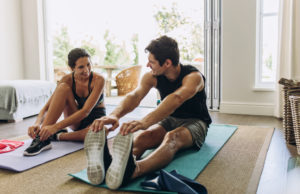 Strictly speaking, ‘lockdown’ is not a scientific term, but describes any of the unprecedented social distancing measures implemented, globally, to slow the spread of the coronavirus (COVID-19) pandemic, which force people to stay at home. Keeping active is paramount to keeping yourself refreshed, invigorated and level-headed but, with fitness studios, gymnasiums, leisure centres and swimming pools closed, doing so without exposing yourself or others to potential infection can pose a significant challenge. However, even if you are confined to your home for most, if not all, of your time, there are various ways in which you can avoid an inactive, sedentary lifestyle and preserve your physical and mental health and well-being.
Strictly speaking, ‘lockdown’ is not a scientific term, but describes any of the unprecedented social distancing measures implemented, globally, to slow the spread of the coronavirus (COVID-19) pandemic, which force people to stay at home. Keeping active is paramount to keeping yourself refreshed, invigorated and level-headed but, with fitness studios, gymnasiums, leisure centres and swimming pools closed, doing so without exposing yourself or others to potential infection can pose a significant challenge. However, even if you are confined to your home for most, if not all, of your time, there are various ways in which you can avoid an inactive, sedentary lifestyle and preserve your physical and mental health and well-being.
Structured Exercise
In the absence of home gym equipment, such as an exercise bike or treadmill, if you want to follow a structured exercise programme while remaining indoors, you should be looking for a selection of cardiovascular and strength training exercises that you can perform without equipment in a confined space. Thankfully, you have plenty of viable options and, if you are at a loss as to where to start, video sharing sites, such as Youtube and Vimeo, offer a plethora of instructional classes, many of which are available free-of-charge. Calisthenics, for example, are exercises that rely solely on your own body weight and require little or no equipment. Calisthenic exercises, such as burpees, or squat thrusts, crunches and pushups, promote coordination, endurance, flexibility and strength, yet can be performed almost anywhere. Other options include pilates and yoga, although it is fair to say that the vast majority of pilates exercises involve equipment that may not be immediately available in your home. By contrast, classic yoga, which seeks to achieve the same ends as pilates, in terms of developing your balance, flexibility and posture, albeit by different means, requires no equipment at all. Much like pilates, yoga emphasises the connection between your physical and mental health. Aside from physical poses, or ‘postures’, which develop flexibility and strength, yoga teaches controlled breathing, meditation and/or relaxation, which can quieten your mind and help to reduce your stress and anxiety levels.
Other Activities
 A structured exercise programme is one way, but by no means the only way, of keeping physically active during lockdown. Even short bouts of physical activity, say, 10 or 15 minutes at a time, can make a difference to your . Of course, if possible, a short walk outside, if only for irregular shopping trips, provides a splendid opportunity for physical activity, not to mention the additional benefits of fresh air and sunshine, subject to the vagaries of the weather. Failing that, walking or marching on the spot or engaging in any leisurely activity, including dancing to music or playing with children, is better than doing nothing. Walking up and down the stairs, too, will improve your agility, cardiovascular fitness and strength. Even everyday domestic tasks, such as dusting, vacuuming, doing laundry or taking out rubbish can contribute, in their own small way, to your physical fitness and peace of mind.
A structured exercise programme is one way, but by no means the only way, of keeping physically active during lockdown. Even short bouts of physical activity, say, 10 or 15 minutes at a time, can make a difference to your . Of course, if possible, a short walk outside, if only for irregular shopping trips, provides a splendid opportunity for physical activity, not to mention the additional benefits of fresh air and sunshine, subject to the vagaries of the weather. Failing that, walking or marching on the spot or engaging in any leisurely activity, including dancing to music or playing with children, is better than doing nothing. Walking up and down the stairs, too, will improve your agility, cardiovascular fitness and strength. Even everyday domestic tasks, such as dusting, vacuuming, doing laundry or taking out rubbish can contribute, in their own small way, to your physical fitness and peace of mind.









